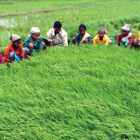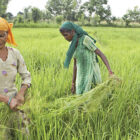How does one correlate the dramatic ‘doubling of farm incomes’ with the growing farmer agitation across the country?
The Indian farming scene seems to be emerging straight from the pages of a black comedy. Why are farmers who have purportedly experienced a doubling of incomes committing suicides? Why are they agitating? One’s intelligence gets seriously tested as one tries to correlate the dramatic announcement of a doubling of farm incomes with the growing farmer agitation across the country.
Farmers commit suicide, they are fired upon, they lay siege to India’s capital in despair and many senior economists, from whom the government seeks counsel, come up with inane and outright insensitive comments: about the “mystery of farmer agitations circa 2017”… which they resolve “is heavily political”.
Surely one has arrived at an inflexion point even given India’s limited understanding of issues agricultural. It seems to have progressed to a deliberate misunderstanding of the situation on the ground by rearranging data, courtesy major changes in the methodology of the National Crime Records Bureau. This was brilliantly exposed by P. Sainath, who has followed it up with detailed explanations on the plight of the farmers.
Farmer suicides increased by 42 per cent in 2015 but, from 2014, farmer suicides are enumerated separately from those of agriculture labour, drastically bringing down the numbers. Thus the disparity in suicide data. Many states like Jharkhand, Chhattisgarh, West Bengal and Odisha refuse to record farmer suicides and now under-report. Even otherwise, farmer suicide data remains unreliable. For example, land is normally registered in the name of men, so when women farmers commit suicide, they do not get counted.
It is a dark satire to tell a farmer that the Minimum Support Price (MSP), CPI and WPI changes reflect a doubling of farmer incomes and that farmer suicides are declining. The trigger for the recent farm agitation are the depressed farm gate prices. The government declares MSPs for some crops but more than two-thirds of all such crops are selling below MSP or far lower than in the previous years. That is what matters on the ground. Worse, over 80 per cent of farm produce is not purchased under MSP. Even vegetable prices are about half.
The BJP’s election manifesto promised an MSP of crop production cost plus 50 per cent, a pricing formula based on the M.S. Swaminathan report but the government quietly filed an affidavit in the Supreme Court stating that it could not be implemented. Farmers are losing hope and faith in this government, just as they did in earlier governments that consistently broke promises.
In Maharashtra last year, farmers were compelled to sell milk for as low as ₹16/litre, compared to the average purchase price of ₹35/litre in many other states. Most farmers keep cattle and were reeling from lower milk prices, impacted by policy-induced imports of butter oil (ghee). They now have to contend with the ban on cow slaughter and buffalo sale restrictions. Every farmer’s cash flow is disrupted. This has added to the pent-up frustration that exploded.
After a decade of bad policies, the farmer agitation in Maharashtra was waiting to happen. What has rattled economists even more is the agitation in Madhya Pradesh, a state where farming was supposedly progressing at an unbelievable double-digit growth rate. Economists with no ‘skin in the game’, who trumpeted farmer prosperity through agriculture GDP and agriculture production numbers, now try to escape the blame by branding the agitation as “political”. Production increases do not translate into income increases. Inversely, when production peaks, farmers suffer.
The farmer agitation is not just about demonetisation-induced farm deflation and poverty, it is also about frustrations arising from unfulfilled aspirations and farmers’ realisation that other communities have progressed at their expense. By wilfully disregarding how farmers remain the primary tool for controlling inflation, academics evade the heart of the farmer distress issue.
The farmer agitation will be the defining image marking three years of the Modi regime. The mess on the farm is not a creation of the Modi regime but expectations were high that Narendra Modi would solve the crisis. Now, with hopes of off-farm jobs and “ache din” evaporating, he is losing the moral authority to carry forward reforms and resorting to a populist agenda, like the UPA.
The larger question is not why farmers are agitating but why agitations do not yield long-term tangible changes to their livelihoods. The demand for a higher MSP or loan waiver does not represent the requirements of all sections dependent on agriculture. The demands of agricultural labour are never raised and, subsequently, farmer agitations lose steam. For the first time, educated youth participated in the farmer agitation and they will eventually bring their families into the movement. Agitations not driven by politicians are a harbinger of tumultuous times. Disorganised farmers have earlier done what the combined opposition could not; bring governments to their knees. More importantly, they have shown that it can be done. Reacting with loan waivers, pandering governments cannot dispel the discontent of alienated farmers but can only prolong the uncertainty and the inevitable. Depressed international commodity prices, plummeting cotton and maize prices during the coming harvest can be the flashpoint for the next farmer agitation.




